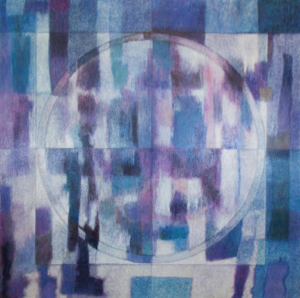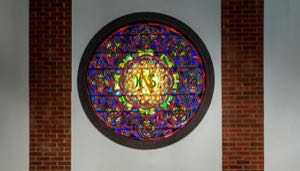FILTER RESULTS
 by Object Type
by Object Type
Windows with Art and Literature Design
Decorative Arts and Furniture
19th to 20th centuryTiffany & Company (1837 – ) Artist
Object Type:
Decorative Arts
Medium and Support:
stained glass on lead
Credit Line:
Gift of Mrs. Tilton in honor of her husband
Accession Number:
2016.63a&b
Web Notes
In 1901, Caroline Stannard Tilton, the widow of wealthy businessman Fredrick Tilton, commissioned Tiffany Studios for the design and creation of two memorial windowsin honor of her husband and herself. These were to be placed in the Tilton Memorial Library on which was being built in the couple’s honor on Tulane University’s campus. The building has had several transitions, first as Tulane’s Library, later became Law School and now home to the Amistad Research Center, an archive dedicated to civil rights, ethnic history and the African Diaspora. Throughout all the transitions for the use of the building, these windows still remain in their original location. They are the only Tiffany Windows on campus that have remained in their original location which has allowed them to remain in relatively good condition. There is some slight buckling at the bottom of the windows, which is not uncommon for Tiffany Windows let alone stained-glass windows in place for over 100 years. If these windows are restored in the future, that buckling can be addressed.
The stained-glass division of Tiffany Studios at the turn of the century was thriving. Owned and operated by Louis Comfort Tiffany, the firm represented one unified vision in the Decorative Arts in America. This is as the Arts and Crafts movement flourished in the US and Europe, and just as the aesthetics of Art Nouveau were taking shape. Most of the Studio’s business came from Christian churches, as either figurative windows depicting scenes from the Bible, or idyllic landscapes designed by Agnes Northrup with quotes from scripture at their base. Allegorical windows like these were often commissioned by hospitals, schools and private clients, and Louis Comfort Tiffany would often guide the patron in the process. Commissions for University’s were often reflective of the Arts and Sciences. The themes of “Art” and “Literature” do of course reflect the Tilton’s interests, as Fredrick Tilton had supported the arts during his lifetime, and the creation of the building was to be Tulane’s Library, stipulated in the will of Mr. Tilton and carried out by his wife. This recognition is related by the themes, with “Art” in memorial to Fredrick and “Literature” to Caroline.
Techniques:
Several techniques are at work here, and if you watched our previous video on the Resurrection and Supper at Emmaus windows, you will recognize a few, starting with the enameled portraiture. Fredrick Wilson, who was the lead designer of Tiffany’s figurative windows at this time created excellent portraits here using enamel, which is fine silica particles painted on the glass and then baked at a temperature high enough to fuse the silica to the glass but not high enough to disrupt the surface of the sheet. This technique was not the easiest to control, and the Studio sometimes had difficulty in accurately matching skin tones.
The previous decades saw advancements in glass technology, including drawing and rolling methods to create better sheet glass. These large steel rollers would often imprint the texture of the rollers on the glass, seen here in the mostly clear and bluish areas between the trellis and each figures’ head.
Opalescent glass: This is a technique Tiffany used in every window his studio produced and it is created by ladling out two or more colors of molten glass on top of each other along with clear glass and then flattened into sheets by steel rollers. The result is very organic, providing swirls and splotches of mixed colors. This can be seen throughout the roses, the trellis, the palette in the middle section of “Art” and the cape or scarf of the “Literature” figure.
Drapery glass: This is a technique that Tiffany invented which is molten glass that is twisted with metal tongs. Kind of like 1000 degrees F pastry dough. This is a very difficult technique to execute, but the results are striking. Called drapery glass because it was usually reserved for depicting cloth, as evident in the robes of the women, the technique produced realistic volume and depth to the windows.
A technique that is used extensively in both windows, but is not used in any of the other Tiffany windows in the Newcomb Art Museum collection is Flashed glass. This starts with two or more sheets of glass heat fused together. The sheet is etched with hydrochloric acid, with an acid resistant wax is placed on the areas that are not to be etched. Here, the flowers on the robes are the areas exposed to the acid. Note other flashed areas that form the background or bottom of the trellis. There are also pieces of translucent glass over some of these areas that create depth. These robes are inspired by the fascination of all things Japanese after the forced opening of Japan to Western trade in 1853. We’ve seen similar kimonos in works by Claude Monet, James Tissot, Whistler, and others, and this is clearly is in the same mindset.
To have two women portraying the allegorical muses is instantly understood, even if New Orleans wasn’t a city with a street named for all 9 muses. Their poses are not quite unique, as “Art” stands contrapposto, a classic pose as both Michangelo’s and Donatello’s Davids are; and “Literature” simply stands as if in mid stride. The verticality of the design is only broken up by the rose trellis, gridding out the windows while allowing for areas of nearly clear glass to exist. The design of both windows is anchored and greatly strengthened by the climbing roses throughout all six panels. My guess on the particular rose is either Crepuscule (Creh-PUS-q ule) or Pierre De Ronsard (because of the pink in the Literature ones). Also, in the hair of “Literature” may be an Apple blossom, which was one of the reoccurring flowers in Tiffany windows. I welcome advice from any level of expertise on this matter.
1901 was a high point in Tiffany’s career, but this came with some growing pains, as certain self-imposed rules and values were bent in order to both keep up with the increasing demand of his patrons, as well as to support the ever growing Studios, which at this point was a major operation with separate teams for each facet of his output. Given this need to quickly create and execute window designs in order to keep up with demand efficiently, the artist increasingly had to cater to the wishes of the client, at times even copying highly revered art works in some part– like the Supper at Emmaus window in our collection. And while Tiffany did not consider himself to be part of the Arts & Crafts movement which nevertheless was blossoming in the United States at this time, this problem was one that was shared by both Tiffany and Arts and Crafts adherents, like the Newcomb Pottery Enterprise here in New Orleans, and actively working just a few miles away from Tulane University on the Newcomb College campus in the Garden District: how to create artisan made work that can be competitive in the age of mass production. I would say that the lack of originality in the composition is one such concession. There are also less examples of plated or layered glass. This was a technique that could be used to create color opacity or depth in the design, and here it is used for both, but as adding pieces of glass on the front and back of a window increases cost, he quickly stopped using so many panels of glass – before the turn of the century he would layer up to six pieces of glass on top of each other, whereas these windows feature two to three layers. The third concession here is only important because it went against what his company advertised. Tiffany Studios claimed that there was no paint used in their windows. They stated this as a way of putting themselves above their competitors. Using paint in stained glass was very common well before and during Tiffany’s career and is not considered so inelegant or of low value. It’s just that Tiffany wanted to use enamel for portraiture and skin tones exclusively, as he wanted to show fine and realistic detail that paint could but allow the light to pass through the entirety as only the glass could. As enamel is glass, that was adopted early in his career as the only acceptable solution. But if you look here in the bust at the right of “Art’s” feet, you can see an example of a painted portrait. The paint not only blocks the light coming through the glass but has been scraped with a knife to carve out the features. The Studio got away with claiming they weren’t using paint when in some cases they were by placing a transparent piece of glass over the dried painted surface.
Both the “Art” and “Literature” windows offer a unique glimpse into what would soon become a turning point in Louis Comfort Tiffany’s career. While 1900 marked his continued ascent both in the United States and his acceptance in Paris with his inclusion in the Exposition Universalle, by 1902, he had started a long obsession shifting away from making and into pedagogy, teaching and self-aggrandizement. This obsession took the form of a 580-acre estate on Long Island named “Laurelton Hall”. As the years continued, he would become less involved in the daily workings of the Studio and more in his ambitious vision for his estate, to include a home, a studio, a school and a museum. This would never fully be realized by the time of his death in 1933, but his legacy as one of the foremost designers of Decorative Arts in America was already in place.
Additional Images
Click an image to view a larger version
Portfolio List
Click a portfolio name to view all the objects in that portfolio
This object is a member of the following portfolios:
 by Object Type
by Object Type


.png)



